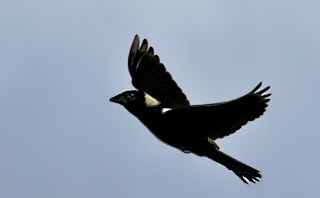The first time I saw Bobolinks was about 30 years ago, when I was just a casual birdwatcher. I was taking my mother, who was visiting from Germany, on a tour of the mountain state that had become my home. We stopped at the Trapp Family Lodge in Stowe, VT, for lunch, but did a look around first. It was a glorious day in mid June. There were several large hayfields on the slopes around the lodge and on them a burbling joyful cacophony, made visual by the spectrogram below, of black and white birds swirling over the fields and riding the fences. Emily Dickenson calls the Bobolink the Sorcerer of the Meadow in her poem "The Way to know the Bobolink" :
"The Way to know the Bobolink
From every other Bird
Precisely as the Joy of him—
Obliged to be inferred.
..........
From every other Bird
Precisely as the Joy of him—
Obliged to be inferred.
..........
"Extrinsic to Attention
Too intimate with Joy—
He compliments existence
Until allured away
He compliments existence
Until allured away
.........
"By Contrast certifying
The Bird of Birds is gone—
How nullified the Meadow—
Her Sorcerer withdrawn!"
The Bird of Birds is gone—
How nullified the Meadow—
Her Sorcerer withdrawn!"
Bobolinks are iconic grassland birds of the northeast and center of the country. The males are easily recognized by their buffy napes, black front and on their backs white shoulder patches and white on their rumps. Many meadows may look empty at first glance but watchful waiting and listening is often rewarded.
They are semi-colonial and need at least 20 acres for a breeding. They prefer wide open grasslands, old hayfields with a mix of grass and broad-leaved forbs. They tend to cluster in the middle of a field away from woody edges. The female builds her nest on her own in a small hollow in the ground weaving old grass and fine sedge together into a thin cup at the foot of a broad-leaved plant which provides shade and leafy shelter. Both she and the male are polygamous Her hatchlings are often fathered by different males. The males have a primary female who gets most of their attention, but they may also breed with, and provide for, other females. The males are generally not territorial, except during courtship, and often flock and sing together.
These were the only two Bobolinks I saw carrying food during several field trips this year.
Below are a series of photos of male Bobolinks on their perches, blades of grass, on which they often do their singing and calling.
Mid-season June mowing will destroy nests and nestlings. To give late nesters and re-nesters a chance mowing is best delay until August. Here's a link to NY Audubon management recommendations. By October most birds have left for their wintering ground south of the Equator, the Argentine pampas.
A couple of weeks ago I sent out an email on the VTBird listserve with title "Where are the Bobolinks?" because they seemed to be absent in the areas where I had seen them before in sizable numbers. For example I took these shots of a feeding pair on a meadow just up from my house in 2008. but I haven't seen any on there for the last several years.
Post Script: An upbeat note from ornithologist Noah
Perlut --who by the way also authored the
Bobolink article in the Atlas of Breeding Birds in Vermont that I mentioned above--
“A mowing program has been developed
for intensive dairy farmers in VT. At
last count, >1300 acres were enrolled--and it has major (positive) benefits
for bobolinks.There is also a new grazing program this year based on our
research that is specifically aimed at increasing habitat for bobolinks,
Savannah sparrows and meadowlarks.”

















